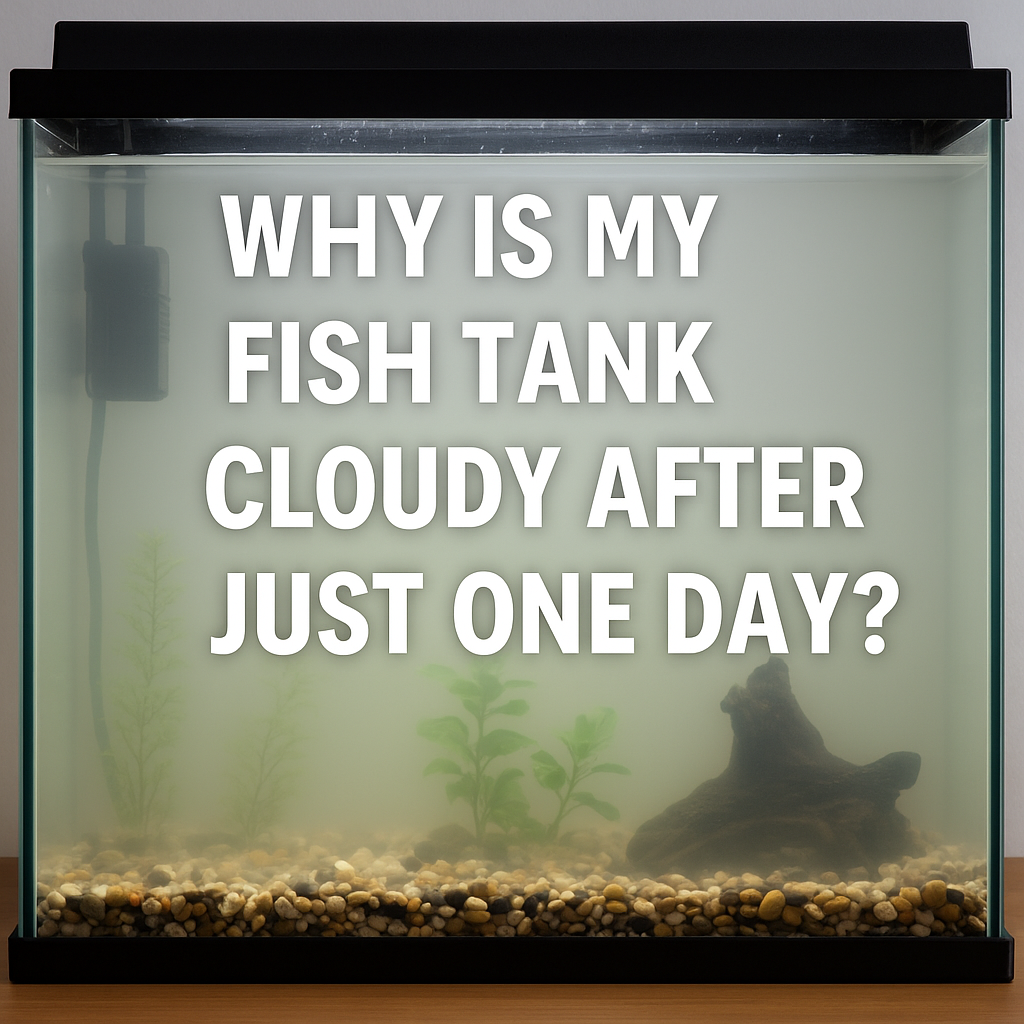So you’ve painstakingly set up your fish tank—gravel washed (you think), filter humming, water sparkling—only to wake up the next day to a murky, ghost-like haze swallowing your aquatic world. Sound familiar?
You’re not alone.
Cloudy aquarium water within 24 hours is an almost universal dilemma among fishkeepers—newbies and veterans alike. It’s not just a cosmetic flaw; it can signal imbalances in your tank’s early ecosystem. Below, we unravel the multifaceted causes behind this sudden cloudiness, provide real-world data from aquarists, and share essential techniques to restore that sought-after crystal clarity.
What’s Really Happening?
The Substrate Storm (Gravel Dust & Fine Sediment)
Unrinsed or improperly rinsed substrate is the most common offender in the opening act of a cloudy tank.
Gravel and sand, especially colored or fine varieties, come coated with ultra-fine particulate matter. Once submerged and stirred, they form a cloudy suspension that resembles powdered milk. Even pre-rinsed gravel may cause mild clouding due to microscopic dust that clings to crevices.
Solution:
Before setting up, rinse your gravel thoroughly under running water—at least until the runoff is completely clear. Consider doing this in a sieve or large bucket, agitating constantly. If you skipped this, don’t fret—run your filter continuously and expect it to clear in 24–48 hours.
Bacterial Bloom
One of the most misunderstood causes of early cloudiness is a bacterial bloom—an explosion of heterotrophic bacteria feeding on organic matter in the water column. These microorganisms are invisible to the naked eye but appear as a milky fog in the tank.
that is why there is a super need for a good quality fish tank heater which will help your aquarium stay fresh in long run
When it happens:
- After adding water conditioner or dechlorinator (which can introduce carbon sources)
- When fish are added before cycling is complete
- When organic debris (uneaten food, decaying plant matter) is present in significant amounts
Why it’s not all bad:
A bacterial bloom means your tank is cycling—establishing biological equilibrium—a critical process where beneficial bacteria begin colonizing your filter media to handle ammonia and nitrite.
Do not panic-clean.
Cloudiness from bacterial blooms usually clears up in 3–7 days. Allow nature to stabilize the tank.
Microscopic Debris & Organic Residue
Even with the substrate rinsed and no bacterial bloom in sight, your tank can still look cloudy due to suspended organic debris. These include:
- Excess fish food
- Detritus from aquatic plants
- Waste particles stirred by bottom-dwellers
Without adequate filtration or water circulation, these specks remain suspended, creating a dull or grey hue in the water.
Solution:
Use fine filter floss or pads in your filtration system. These trap even the most minuscule particles. Combine this with moderate water flow and strategic vacuuming of the substrate.
Hidden Causes Most Beginners Miss
Tap Water Chemistry
Municipal water often carries dissolved minerals, phosphates, and silicates that, once introduced into your tank, react with other compounds. This can lead to clouding, especially in soft water setups. Water conditioners may also release colloidal compounds that fog up tanks temporarily.
Solution:
Test your water’s GH (General Hardness), KH (Carbonate Hardness), and pH using a reliable kit. In some cases, switching to RO (reverse osmosis) water or using activated carbon in your filter can mitigate haziness.
Overstocking or Overfeeding
Adding too many fish at once or feeding in excess accelerates waste production and ammonia spikes—both of which feed bacterial blooms and foul the water.
Remember:
In a new tank, always add fish slowly and feed sparingly—what they consume in under two minutes. Anything more becomes cloud-fuel.
Inadequate Filtration or Wrong Media
Filtration is your tank’s liver—it must be strong enough to process biological waste and fine-tuned to your bioload. Using the wrong type of media (e.g., coarse sponge instead of fine floss) may allow particles to recirculate.
Upgrade tips:
- Use multi-stage filtration: mechanical + biological + chemical
- Add activated carbon or Purigen to absorb tannins and fine particulates
- Clean your filter gently, without tap water, to preserve beneficial bacteria
Preventing Cloudiness in the Future
- Always rinse substrate thoroughly before setup
- Cycle your tank for 4–6 weeks before adding fish
- Test water frequently, especially in the first month
- Limit lighting to 6–8 hours/day to prevent algae bloom
- Clean filters monthly, not weekly, and never all at once
- Add live plants, which outcompete bacteria and algae for nutrients
- Use seeded media or bottled bacteria to jump-start your biofilter
Most Googled FAQs About Cloudy Aquarium Water
Why is my tank cloudy after just one day with no fish?
If your tank is unstocked and turns cloudy, the cause is usually gravel dust or a bacterial bloom. Even without fish, organics like decaying plant matter or dechlorinator additives can feed bacteria.
Is cloudy water dangerous to my fish?
Mild cloudiness is often harmless, but persistent murkiness—especially with ammonia spikes—can stress or even kill fish. Always test your water. Cloudiness + gasping fish = emergency.
How long should it take for a cloudy tank to clear?
Dust settles within 24–48 hours. Bacterial blooms may take 3–10 days. If cloudiness lingers beyond 2 weeks, test water and review your feeding/stocking habits.
Should I do a water change if the water is cloudy?
Only if ammonia or nitrites spike. For bacterial blooms, doing water changes can prolong the process. Let the tank stabilize naturally unless parameters are toxic.
Can I use clarifiers or UV sterilizers to fix cloudy water?
Yes—clarifiers bind particles into larger clumps your filter can catch. UV sterilizers zap free-floating bacteria and algae. Both can offer short-term clarity but won’t fix the root cause.
Final Reflection
A cloudy tank may look like failure, but it’s often the start of a thriving aquatic microcosm. Nature never rushes—and aquariums are no exception. Water becomes clear when chaos gives way to balance. Trust the process, test often, and intervene only when needed.
